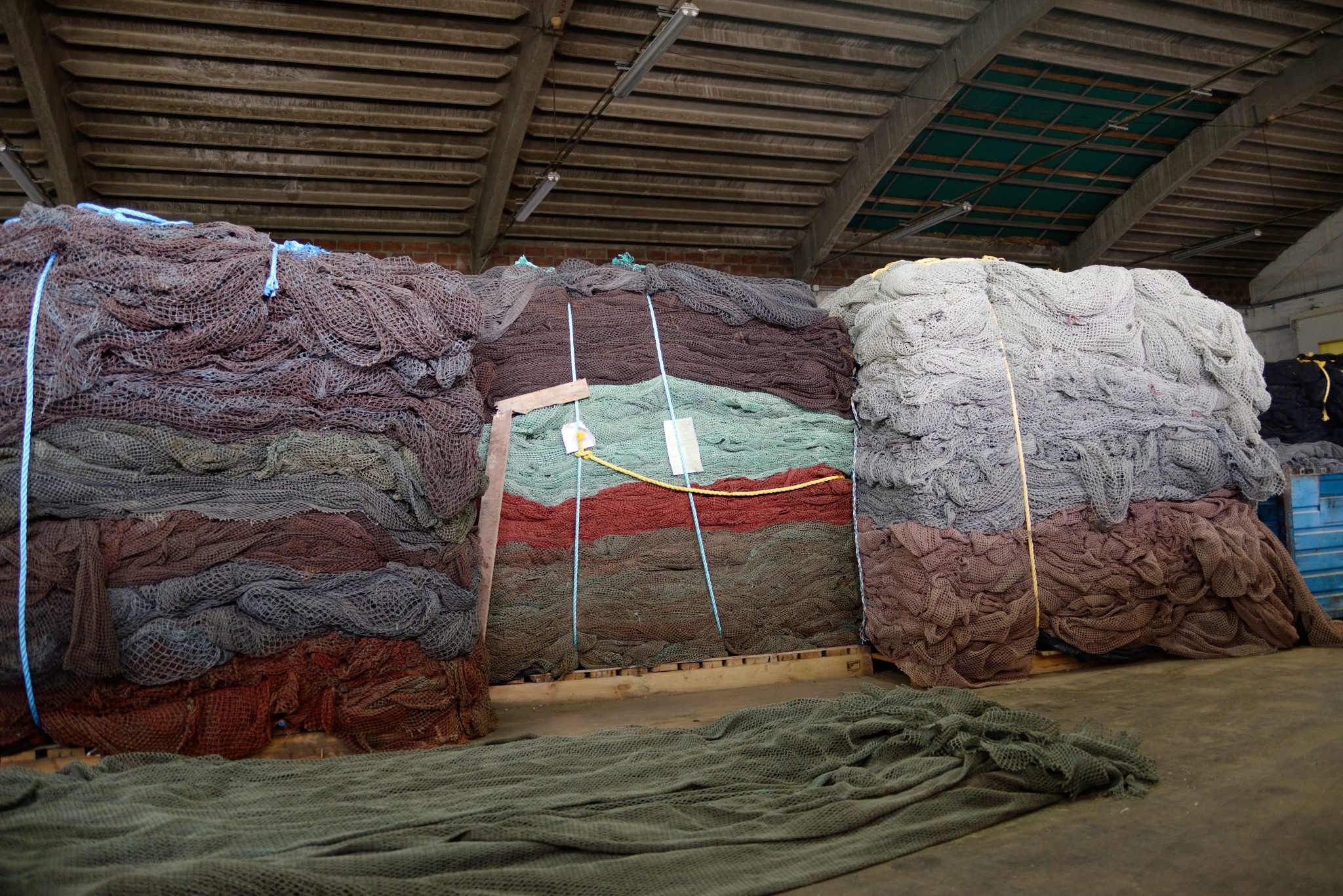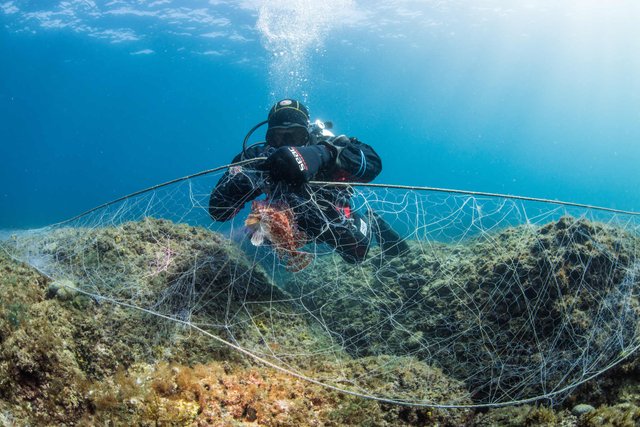How ghost fishing nets get turned into great socks
Unseen from above, every one of our seas and oceans is littered with ghost fishing nets. Drifting and catching on coral and shipwrecks these discarded fishing nets and ‘ghost gear’ act as huge traps - for fish, for turtles, sharks, whales or dolphins and they can wreck entire marine ecosystems.
These nightmare nets make up 10% of the marine litter in every ocean. Not only are they a death web for marine wildlife, but they’re often made of synthetic materials which break down slowly - and we’re talking centuries. The ghost fishing nets then leach tiny micro-plastic molecules and polyurethane chemicals into the water, into the fish and into our food chains.

“According to scientific reports, every year some 640,000 tonnes of fishing gear are left in our seas and oceans,” says Veronika Mikos, Project Co-ordinator at Healthy Seas. “Oceanic currents and winds can carry ghost fishing gear thousands of kilometres. Even remote Antarctic habitats are not free from this pollution, every ocean and sea on earth is affected.”
The ghost nets are also indiscriminate, killing off crabs and fish that the fishing industries rely on all over the world. Over eight years 870 nets were removed from the coastline of Washington state in the US - entangled were over 32,000 marine animals.
The fact that it’s a global problem is recognised by the UN, who made reducing ghost gear and fishing nets part of its Sustainable Development Goals and an Ocean Conference held at the UN in New York in June saw different countries discuss ways to combat the issue.
Healthy Seas is a collaborative initiative between NGOs and businesses that rescues ghost gear from the ocean. It operates with divers and salvage experts in the North Sea, Adriatic and Mediterranean Sea to remove fishing nets but also works with fish farms and the fishing industry to reduce their waste.
“Since the start of Healthy Seas in 2013 we have removed more than 311 tons of lost or abandoned fishing nets.” explains Mikos. “We can’t save the world alone, but by doing something good we hope to inspire others to follow.”
Healthy Seas works with 75 expert volunteer divers, who might have to work at up to 60 metres deep to remove the ghost gear from shipwrecks.
“With divers we can collect around 300kgs of net,” says Mikos. “Using salvage companies and divers we can collect up to 10,000kgs in a couple of days.”
It’s around shipwrecks that the discarded fishing nets cause the most problems. Shipwrecks offer a diverse breeding ground for everything from microorganisms upwards and entangled nets can cause irreversible damage for hundreds of years.
But removing the nets is only half the story.

What is ECONYL?
You might have seen ECONYL written next to sustainable clothing or ethically made shoes. It’s the yarn that is produced from fishing nets and other consumer plastic waste. Healthy Seas send their fishing nets (after cleaning them) to Slovenia where an innovative factory turns them into a yarn that's as good as original nylon. Healthy Seas' partner, Aquafil, makes ECONYL for Speedo and Outerknown (both in our summer ethical swimwear round up).
Not only is upcycling the ghost fishing nets into yarn that can be used in swimwear, socks, shoes and sportswear a sustainable thing to do but the process of turning these old fishing nets into ECONYL is more eco-friendly than normal nylon production.
From virgin oil to finished nylon takes five phases, from fishing nets to ECONYL is only three - the production process generates 55% less CO2 emissions than original nylon. ECONYL is also a great example of how a material can move from a linear production process to a circular one - the made-from-waste product can be used again and again without creating any more waste.
But this isn’t ‘a breathe easy, we’ve found a solution’ solution.
To give you some idea of the scale of the problem - one tonne of fishing nets makes enough ECONYL for 10,000 swimsuits or 26,000 pairs of socks . Remember it’s estimated that 640,000 tonnes of ghost fishing nets are left in the ocean each year. That’s a lot of eco-friendly shoppers buying a lot of swimsuits and more socks than you could lose in a lifetime.
The upcycling also doesn’t cancel out the environmental damage being caused or make up for the numbers of marine wildlife being lost.

Obviously the ideal future situation is that there wouldn’t be any ghost fishing nets clogging up our seas. Healthy Seas work with various fishing industries to encourage them to dispose of old nets in a safer way,
“We aim to engage the fishing industry and aquaculture more and more in the responsible handling of waste fishing nets at the end of their life and eventually closing the loop,” says Mikos. “We want to raise awareness of the problem of marine litter and possible solutions, and help develop the right attitude among fishermen and other stakeholders in the fishing industry so they become more sustainable in their operations.”
Fishermen have to become the first line of defense in the combat effort to stop the nets being discarded or lost in the first place.
“Ghost nets keep fishing uncontrolled and lead to unnecessary catch of fish stocks, so it’s also a loss for fishermen and an economic damage for the fishing industry,” explains Mikos.
From fishermen changing their industry to choosing to support brands who use ECONYL, there's still a long way to go at every level but there are more people than ever trying to combat the net effect.
Bienvenido a Steemit! Este Post puede tener muchos upvotes con la ayuda del King: @dineroconopcion, El cual es un Grupo de Soporte mantenido por @wilbertphysique, @yoenelmundo y 5 personas mas que quieren ayudarte a llegar hacer un Top Autor En Steemit sin tener que invertir en Steem Power.Te Gustaria Ser Parte De Este Projecto? Click aquí para ir al grupo de Discord donde hablamos de steemit y criptomonedas
Welcome to Steemit! This Post can have many upvote's with the help of the King's Account: @dineroconopcion, It's a Support Group run by @wilbertphysique, @yoenelmundo, and 5 other people that want to help you be a Top Steemit Author without having to invest into Steem Power. Would You Like To Be Part of this Project? Click here, go to group discord where we talk about steemit and cryptocurrency